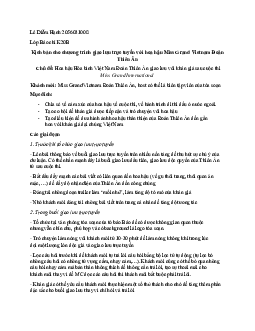




Preview text:
MODELS OF COMMUNICATION Models:
Aim to present communication as a process.
It is like a map, representing features of a territory. But it cannot be comprehensive.
We need therefore to be selective, knowing why we are using it and what we hope to gain from it.
Transmission models - criticism
The Shannon and Weaver and Lasswell model are typical of so-called transmission
models of communication. These two models also typically underlie many others in
the American tradition of research, showing Source-Message/Channel-Receiver as
the basic process of communication. In such models, communication is reduced to
a question of transmitting information.
Although transmission models have been highly influential in the study of human
communication, it can be argued that, although Shannon's and Weaver's work was
very fertile in fields such as information theory and cybernetics, it may actually
be misleading in the study of human communication.
Some criticisms which could be made of such models are: The conduit metaphor
Their model presents us with what has been called the 'conduit metaphor' of
communication (Reddy (1979) The source puts ideas into words and sends the words
to the receiver, who therefore receives the ideas. The whole notion of 'sending'
and 'receiving' may be misleading, since, after all, once I've 'sent' a message, I
still have it. The underlying metaphor is of putting objects into a container and
sending them through some sort of conduit to the receiver who receives the
containers and takes the objects out. The important question which is overlooked
is: How do the 'objects' get into the 'containers'? In other words, how do we
succeed in putting meanings 'into' words and how does somebody else succeed in
taking the meanings 'out of' words? Transmission models don't deal with meaning.
It's probably worth saying that that's not really a criticism of them, since
they weren't intended to deal with meaning, but rather a criticism of their www.geoffbarton.co.uk Models summary April 13, 2024 1 of 5 lOMoAR cPSD| 40799667
(mis)application to human-to-human communication. One might question how useful
the application of information theory is. It may be helpful to academics in that it
supplies them with an arcane vocabulary which gives them some kind of kudos. It also
appears to offer a 'scientific' methodology, but it's worth bearing in mind Cherry's
warning (speaking of the relationship between entropy and information):
...when such an important relationship ... has been exhibited, there are two ways in
which it may become exploited; precisely and mathematically, taking due care
about the validity of applying the methods; or vaguely and descriptively. Since this
relationship has been pointed out, we have heard of 'entropies' of languages, of
social systems, and economic systems and of its use in various method-starved
studies. It is the kind of sweeping generality which people will clutch like a straw. Cherry (1977) 1950s: Early models
Mass communication research was always traditionally concerned with political
influence over the mass press, and then over the influences of films and radio. The
1950s was fertile for model-building, accompanying the rise in sociology and
psychology. It was in the USA that a science of communication was first discussed.
The earliest model was a simple sender-channel-message-receiver model.
Modifications added the concept of feedback, leading to a loop.
The next development was that receivers normally selectively perceive,
interpret and retain messages.
Gerbner is important because he recognises the TRANSACTIONAL nature of much
communication – ie the “intersubjectivity of communication”. The result is that
communication is always a matter of negotiation and cannot be predicted in advance.
Communication to mass communication
Early on, a sub-set of models began to refer specifically to mass communication.
Westley and Maclean were important in this. Their model emphasises the
significance of audience demand rather than just the communicator’s purpose. 1960s and 1970s www.geoffbarton.co.uk Models summary April 13, 2024 2 of 5 lOMoAR cPSD| 40799667
The attention now moved away from the effects of the mass media on opinions,
behaviour and attitudes, and began to focus on the longer-term and socialising
effects of the mass media. The audience were less victims of the media, and
more active in adopting or rejecting the guidelines offered by the mass media.
This an emphasis on “an active audience”.
Nevertheless a healthy suspicion of the mass media has continued through
the 1970s and 1980s, especially in terms of news selection and presentation.
A more recent development is an interest in the ‘information society’ when the
‘boundary separating mass communication from other communication processes
is becoming much less clear”. There has also been an accelerating
“internationalisation” of mass communication. Basic models include: Model Comment Lasswell formula Useful but too simple. (1948)
It assumes the communicator wishes to influence the
receiver and therefore sees communication as a persuasive process.
It assumes that messages always have effects.
It exaggerates the effects of mass communication. It omits feedback.
On the other hand, it was devised in an era of political propaganda
It remains a useful INTRODUCTORY model
Braddock (1958) modified it to include circumstances, purpose and effect Shannon and
Highly influential and sometimes described as “the most Weaver (1949)
important” model (Johnson and Klare)
Communication is presented as a linear, one-way process
Osgood and Schramm developed it into a more circular model
Shannon and Weaver make a distinction between source and
transmitter, and receiver and destination – ie there are two
functions at the transmitting end and two at the receiving end
Criticised for suggesting a definite start and finish to the
communication process, which in fact is often endless Gerbner (1956)
Special feature of this model is that is can be given
www.geoffbarton.co.ukModels summary April 13, 2024 3 of 5 lOMoAR cPSD| 40799667
different shapes depending on the situation it describes
There is a verbal as well as visual formula (like Lasswell): 1 someone 2 perceives an event 3 and reacts 4 in a situation 5 through some means 6 to make available materials 7 in some form 8 and context 9 conveying content 10 with some consequence
The flexible nature of the model makes it useful.
It also allows an emphasis on perception
It could explain, for example, the perceptual problems of a
witness in court and, in the media, a model which helps us to
explore the connection between reality and the stories given on the news Westley & Another influential model MacLean (1957)
The authors were keen to create a model which showed the
complexities of mass communication - hence the emphasis on
having to interpret a mass of Xs (events which are communicated in the media)
It oversimplifies the relationships between participants by
not showing power relations between participants
It makes the media process seem more integrated than it may actually be
It doesn’t show the way different media may have different
interests of the state (eg difference between a state broadcaster and private one)
Ritual models of communication
Early models were based on a transmissive or transportation approach (ie
assuming that communication was one-way). James Carey in 1975 was the first to
challenge this. He suggested an alternative view of communication as ritual in
which communication is “linked to sharing, participation, association, fellowship …
the maintenance of society in time; not the act of imparting information but the
representation of shared beliefs”.
As a result there is more emphasis on signs and symbols. Medium
and message are harder to separate. Communication is seen as www.geoffbarton.co.uk Models summary April 13, 2024 4 of 5 lOMoAR cPSD| 40799667
timeless and unchanging. The Christmas tree represents the model – it symbolises
ideas and values of friendship and celebration but has no instrumental purpose.
The tree is both medium and message.
Communication as display and attention
As well as transmissive and ritual models, there is a third. This aims to catch and
hold our attention. The main goal is economic = consumption. This makes sense in
terms of a mass media audience who use the media for entertainment and
escapism. The media here works like a magnet, attracting the audience temporarily
and sometimes repulsing. The theory is associated with Altheide & Snow (1979) and McQuail (1987). Fun things to do: 1
Apply Shannon and Weaver’s model to an analysis of these examples of communication: A job interview A new photograph A pop song How applicable are they?
How helpful is this kind of analysis? 2
Think of other examples which illustrate the RITUAL model. Explain
the shared values they seem to represent. 3
What strengths and weaknesses can you see with the ‘attention’ model?
4(a) Draw a picture of a model trainset
4(b) Apply to become a supermodel. Earn lots of money and then send it to Mr Barton. . www.geoffbarton.co.uk Models summary April 13, 2024 5 of 5



